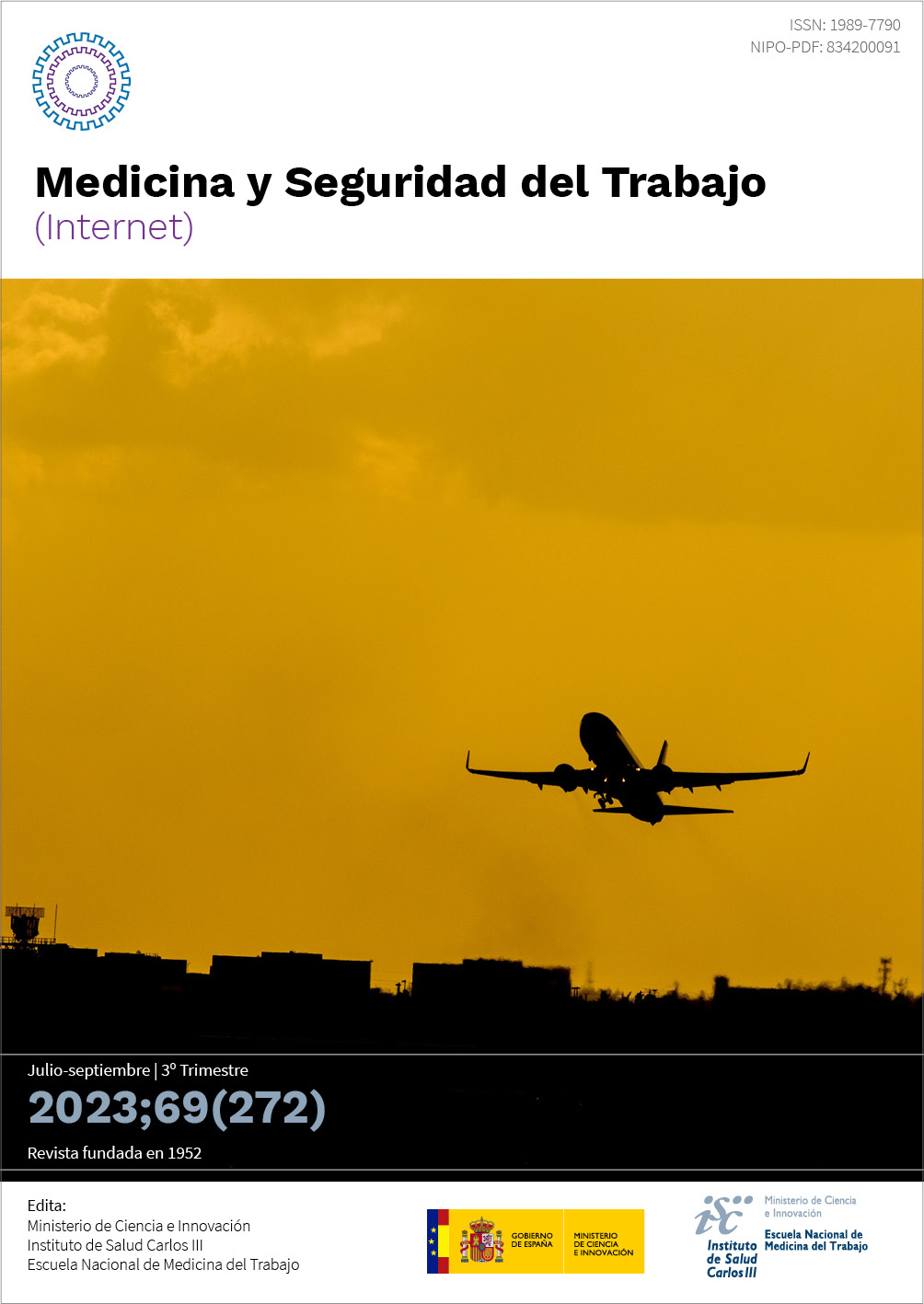Pérdida Auditiva Oculta, Sinaptopatía Coclear y Ruido Ocupacional
DOI:
https://doi.org/10.4321/s0465-546x2023000300005Palabras clave:
Pérdida auditiva oculta; Sinaptopatía coclear; Ruido ocupacionalResumen
Introduction: Cochlear synaptopathy after noise exposure (CSNE) is defined as the transient or permanent functional damage to the ribbon synapsis of the inner hair cells of the cochlea. This article has the objective of comment the usefulness of early identification of the hidden hearing loss after CSNE based on audiological markers and in changes in the clinical methodology in clinical groups for its searching.
Method: Review of related literature in scientific databases and narrative description of results.
Results: CSNE results in a hidden hearing loss in patients with normal pitch audiogram, mainly workers or individuals exposed to high noise levels. The main studies of identification have been performed mainly in groups of students from college or musicians.
Conclusions: Is necessary adjustments in hearing health policy for an wide early identification of CSNE in at risk populations for the identification of the hidden hearing loss and fight for its damage regulation.
Descargas
Referencias
Kujawa SG. Liberman MC. Adding insult to injury: cochlear nerve degeneration after “temporary” noise-induced hearing loss. J Neurosci 2009;29(45):14077–85. doi:101.523/JNEUROSCI.2845-09.2009
Chen G-D. Hidden cochlear impairments. J Otol 2018;13(2):37-43. doi:10.1016/j.joto.2018.05.001
Schaette R, McAlpine D. Tinnitus with normal audiogram: physiological evidence for hidden hearing loss and computational model. J Neurosci 2011;31(38):13452. doi:10.1523/JNEUROSCI.2156-11.2011
Musiek F, ChermakG, Bamiou DE, Shinn J. CAPD: the most common ´hidden hearing loss´. ASHAWIRE 2018. https//doi.org/10.1044/leader.FMP.23032018.6.
OSHA. Occupational noise exposure. Workers´ rights. Available in: https://www.osha.gov/noise
Sarrazin N. Music and the child. Open Suny Textbooks. NY. 2016.
Loera-González M de los A, Salinas-Tovar S, Aguilar-Madrid G, Borja-Aburto VH. Hypoacusia as a result of chronic traumatic acoustic lesion in workers with affiliation to the Mexican Social Security Institute, 1992-2002. [in Spanish] Rev Med Inst Mex Seguro Social 2006;44(6): 497-504.
Tremblay KL, Pinto A, Fischer ME, Klein BEK, Klein R, Levy S, et al., Self-reported hearing difficulties among adults with normal audiograms : the Beaver Dam Offspring Study. Ear Hear 2015;36(6):e290-299. doi:10.1097/AUD.0000000000000195
Kwon JK, Lee J. Occupational hearing loss. In: Wang T-C (ed). Hearing loss. From multidisciplinary teamwork to public health. IntechOpen, Zagreb. 2021, p. 1-19.
Costa-Meira T, Sousa Santana V, Ferrite S. Gender and other factors associated with the use of hearing protection devices at work. Rev Saude Publica 2015;49:76. doi:10.1590/S0034-8910.2015049005708
Barrero JP, López-Perea EM, Herrera S, Mariscal MA, García-Herrero S. Assessment and modeling of the influence of age, gender and family history of hearing problems on the probability of suffering hearing loss in the working population. Int J Environ Res Pub Health 2020;17(21):8041. doi:10.3390/ijerph17218041
Prendergast G, Guest H, Munro K, Kluk K, Léger A, Hall DA, et al., Effects of noise exposure on young adults with normal audiograms. I: Electrophysiology. Hear Res 2017;344:68-81. doi:10.1016/j.heares.2016.10.028
Lobarinas E, Spankovich C, Le Prell CG. Evidence of “hidden hearing loss” following noise exposures that produce robust TTS and ABR wave I amplitude reductions. Hear Res 2017;349:155-63. doi:10.1016/j.heares2016.12.009
Le Prell C. Hidden versus not so hidden hearing loss. Can Audiol 2023;10:1-16.
Liberman MC, Epstein MJ, Cleveland SS, Wang H, Maison SF. Toward a differential diagnosis of hidden hearing loss in humans. PLOS One 2016;11(9):e0162726. doi:10.1371/journal.pone.0162726
Jerger J, Hayes D. Latency of the acoustic reflex in eight-nerve tumor. Arch Otolaryngol 1983;109(1):1-5. doi:10.1001/archotol.1983.00800150005001
Guest H, Munro K, Plack CJ. Acoustic middle-ear-muscle-reflex thresholds in humans with normal audiograms. No relations to tinnitus, speech perception in noise, or noise exposure. Neuroscience 2019;407:75-82. doi:10.1016/j.neuroscience.2018.12.019
Official Journal of the European Union 2003. Directive 2003/10/EC of the European Parliament and of the Council on the minimum health and safety requirements regarding the exposure of workers to the risks arising from physical agents (noise). https://eurlex.europa.eu/LexUriServ/LexUriServ.do
Skoe E, Kraus N. A little goes a long way: How the adult brain is shaped by musical training in childhood. J Neurosci 2012;32(34):11507-10. doi:10.1523/JNEUROSCI.1949-12.2012
Descargas
Publicado
Número
Sección
Licencia
Derechos de autor 2024 Yolanda R. Peñaloza-Lopez, Ma. de los Angeles Loera-Gonzalez, Felipe García-Pedroza, Adrián Poblano

Esta obra está bajo una licencia internacional Creative Commons Atribución-NoComercial-CompartirIgual 4.0.








